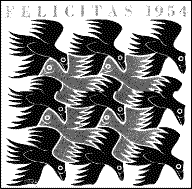

This page is barely started, and is still very much under construction.
 This is a gallery
of a few Escher drawings, lithographs, and woodcuts. There are two nice
things about this gallery: first, the images live on various FTP servers
around the U.S. and Europe, and second, each picture is accompanied by
the date, media, and some commentary (usually by Escher himself) regarding
that particular work. This gallery will eventually contain representative
works from the following categories:
This is a gallery
of a few Escher drawings, lithographs, and woodcuts. There are two nice
things about this gallery: first, the images live on various FTP servers
around the U.S. and Europe, and second, each picture is accompanied by
the date, media, and some commentary (usually by Escher himself) regarding
that particular work. This gallery will eventually contain representative
works from the following categories:
M.C. Escher preferred to work with indirect media. He rarely produced a finished work as a painting or drawing. Instead, he would produce one or more negative images by cutting them into wood or metal. Then, he would produce a small number of prints, and afterwards destroy the cuts from which the prints were made. Original prints of Escher works are highly prized.
These works date from before 1937.
On the assumption that the period of language confusion coincided with the emergence of different races, some of the building workers are white and others black. The work is at a standstill because they are no longer able to understand each other. Seeing that the climax of the drama takes place at the summit of the tower which is under construction, the building has been shown from above, as though from a bird's eye view. This called for a sharply receding perspective. It was not until twenty years later that this problem was thoroughly thought out.
The convergence of the vertical lines towards the nadir suggests the height of the building in which the viewer finds himself, together with the feeling of vertigo that takes hold of him when he looks down.
Three little houses stand near one another, each under a cross-vaulted roof. We have an exterior view of the left-hand house, an interior view of the right-hand one, and either an exterior or interior view of the one in the middle, according to choice. There are several similar inversions illustrated in this print; let us describe one of them. Two boys are seen, [each] playing a flute. The one on the left is looking down through a window onto the roof of the middle house; if he were to climb out of the window he could stand on the roof. And then if he were to jump down in front of it he would land up one story lower, on the dark colored floor before the house. And yet, the right-hand flute player who regards that same cross-vault as a roof curving above his head, will find, if he climbs out of his windows, that there is no floor for him to land on, only a fathomless abyss.
The endless stairs which are the main motif of this picture were taken from an article by L.S. and R. Penrose in the February, 1958 issue of the British Journal of Psychology. A rectangular inner courtyard is bounded by a building that is rooted in a never-ending stairway. The inhabitants of these living quarters would appear to be monks, adherents of some unknown sect. Perhaps it is their ritual duty to climb those stairs for a few hours each day. It would seem that when they get tired they are allowed to turn about and go downstairs instead of up. Yet both directions, though not without meaning, are equally useless. Two recalcitrant individuals refuse, for the time being, to take any part in this exercise.
In the horizontal central strip there are birds and fish equivalent to each other. We associate flying things with the sky, and so for each of the bloack birds the sky in which it is flying is formed by the four white fish that encircle it. Similarly, swimming makes us think of water, and therefore the four black birds that surround a fish become the water in which it swims.
The subject of this colored woodcut is once again the contrast between day and night. But in this instance, the two notions are not, as in Day and Night, pictured as next to each other but in the same place - though not simultaneous, being separated by a leap of the mind.
These works date from after 1960.
An endless ring-shaped band usually has two distinct surfaces, one inside and one outside. Yet on this strip nine red ants crawl after each other and travel the front side as well as the reverse side. Therefore the strip has only one surface.
This page written by Neal Ziring, last modified 10/21/98.